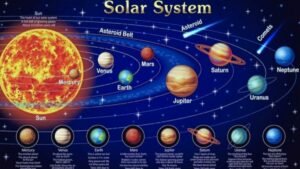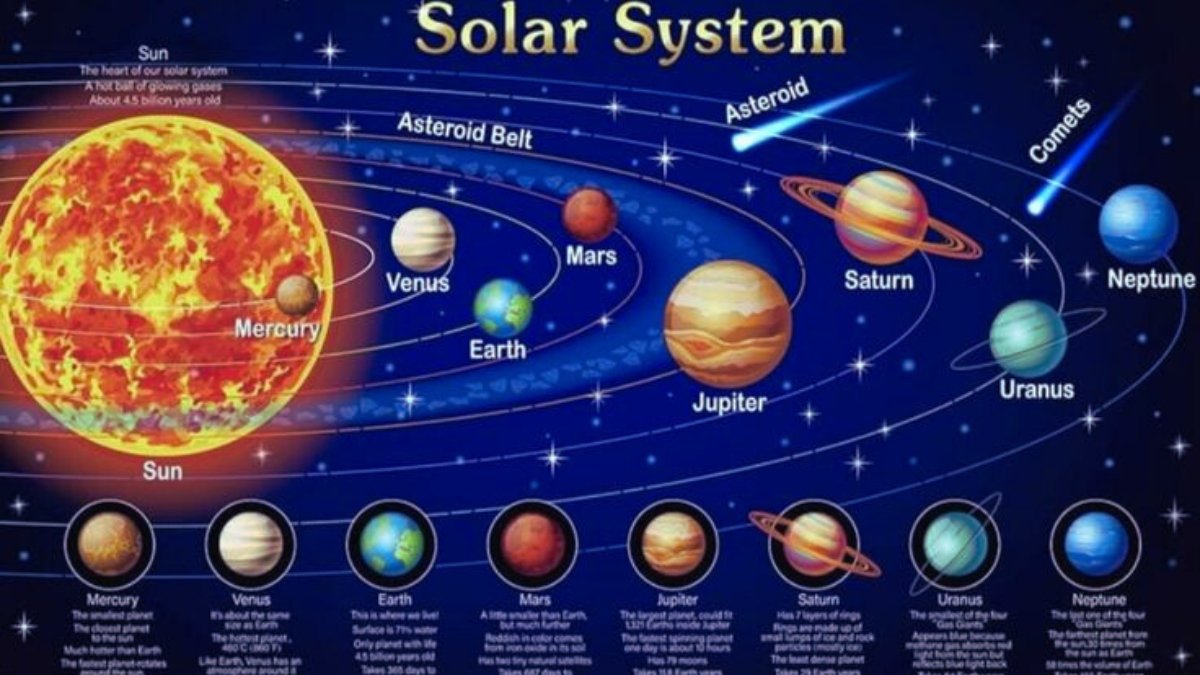Solar System:all upcoming competitive exams.

1. The light from the Sun reaches the Earth in about
1) 8 seconds
2) 8 minutes
3) 10 seconds
4) 10 minutes
Ans:- 2) 8 minutes
• Light travels at 1,86,000 miles per second.
• The Earth is located at an average distance of 93 million miles from the Sun.
• It takes 8.33 minutes for light from the sun to reach the Earth.
• The diameter of the Sun is 109 times greater than the diameter of the Earth.
—————————————————————————–
2. Which amidst the following planets has its orbit closest to Sun?
1) Venus
2) Mars
3) Jupiter
4) Uranus
Ans:- 1) Venus
• Venus is the brightest planet in the solar system.
• Yellow clouds of sulfuric acid reflect sunlight brightly.
• The planets Venus & Uranus rotate clockwise.
• It is called the “morning star” or “silver dot”.
——————————————————————————-
3. Which of the following is called the twin of the earth?
1) Neptune
2) Venus
3) Mars
4) Saturn
Ans:- 2) Venus
• Venus is the second planet from the Sun and the nearest neighbor to Earth.
• It is similar to Earth mainly in its size & some other characteristics. That is why it is often considered as Earth’s twin.
• One day on Venus is equal to 243 Earth days.
—————————————————————————
4. Which is the hottest planet in the Solar System?
1) Jupiter
2) Saturn
3) Venus
4) Uranus
Ans:- 3) Venus
• Mercury is closer to the Sun. However, Venus’s atmosphere is actually hotter.
• Venus:- It has no satellites. Its rotation period (243 days) is longer than its orbital period (224.7 days).
• It contains 90 to 95 percent carbon dioxide.
——————————————————————————
5. The planet nearest to the Sun is :
1) Earth
2) Mercury
3) Mars
4) Venus
Ans:- 2) Mercury
• Mercury is the innermost planet (closest to the Sun) in the solar system.
• Mercury:- It is the closest planet to the Sun (58 km) and the smallest planet in the solar system. Its orbital period is 88 days, the shortest of all the other planets in the solar system.
• Its diameter is 4827 km, or 40% of the size of the Earth.
• It has no satellites because its gravitational force is very low.
• Mercury – Venus – Earth – Mars – Jupiter – Saturn – Uranus – Neptune
————————————————————————-
6. The mass of Jupiter is approximately
1) one tenth of the solar mass
2) one thousandth of the solar mass
3) one hundredth of the solar mass
4) half the solar mass
Ans:- 2) one thousandth of the solar mass
• The radius of Jupiter is about 1/10 of the radius of the Sun.
• Its mass is 0.001 times (1/1000) the mass of the Sun.
• Galileo discovered this planet and its 4 moons in 1610.
• It has the shortest orbital period, completing one rotation in just 9 hours and 50 minutes.
—————————————————————————
7. Which planets do not have satellites revolving around them?
1) Mars and Venus
2) Mercury and Venus
3) Mars and Mercury
4) Neptune and Pluto
Ans:- 2) Mercury and Venus
• Out of the nine planets, only Venus and Mercury do not have natural satellites. (More information about these planets is given in the description above)
————————————————————————–
8. Which among the following planet is called as Veiled planet?
1) Mars
2) Jupiter
3) Venus
4) Satum
Ans:- 3) Venus
• Venus:-Venus is surrounded by a thick layer of clouds. That is why it is called the Veld planet. This planet is the planet with the highest temperature and the highest brightness.
• Mars:- It is the red planet of the solar system and has two moons, Phobos and Deimos. It appears red due to its high iron oxide content.
• Jupiter:- The largest planet in the solar system. It is called the winter planet because its average temperature is very low. Ganymede is its satellite. It is the largest satellite in the solar system.
• Saturn:- It has 53 satellites.
• [NCERT Chapter:- The Earth in Solar System]
—————————————————————————
9. A small Heavenly matter of rocks which fall on earth is called
1) Asteroids
2) Metrology
3) Galaxy
4) Comets
Ans:- 2) Metrology
• Small pieces of rock that move around the sun are called meteors. They sometimes come close to the earth. But due to the friction of the air in the atmosphere, the meteor burns up. It sheds bright light in space.
• Sometimes meteors do not burn up completely in the atmosphere and hit the Earth. These are commonly called shooting stars. They are also called meteorites.
• Asteroids:- Small celestial bodies made up of small rocks and large boulders, with an average diameter of approximately 350 km, are called asteroids. They are usually found between Mars and Jupiter.
• Galaxy:- A small group of stars is called a galaxy or a cluster of stars. The Sun is also a star.
• Comet (Babylon):- A ball-shaped object made of dust and ice that orbits the Sun. A comet has a bright head and a long tail that always points away from the Sun.
—————————————————————————-
10. Which of the following is called “Blue Planet”?
1) Saturn
2) Earth
3) Jupiter
4) Mars
Ans:- 2) Earth
• Earth is the only planet that has diverse living organisms.
• This is due to the Earth’s atmosphere, the presence of water, and its ideal distance from the Sun.
• The third planet from the Sun is Earth. This planet appears blue from space because two-thirds of its surface is covered with water. Therefore, it is called the Blue Planet. This means that 71% of the Earth is covered with water.
• It is the fifth largest planet in terms of size. At the poles, it is slightly flattened. The shape of the Earth is defined as a geoid.
————————————————————————–

11. The outermost layer of the Sun is called
1) Chromosphere
2) Photosphere
3) Corona
4) Lithosphere
Ans:- 3) Corona
• The outer layer of the Sun is the corona. Only visible during eclipses. It is a low-density plasma cloud with greater transparency than the inner layers.
• The white corona is a million times dimmer than the inner layers of the Sun, but many times larger.
• The Sun is composed of 71% hydrogen, 27% helium, and the rest of the gas.
—————————————————————————
12. The total number of planets revolving around the sun is
1) Five
2) Eight
3) Seven
4) Six
Ans:- 2) Eight
• There are 8 planets revolving around the sun under the influence of gravity.
•They are •Mercury-Venus-Earth-Mars-Jupiter-Saturn-(Uranus) (Neptune).
• All the planets revolve around the sun in an oval shape.
• on August 24, 2006, there were nine planets in the Solar System, including Until the recent international conference held in Prague, the capital of the Czech Republic,Pluto. The conference of astronomers concluded that Pluto is not a planet.
——————————————————————————
13. A spinning neutron star is known as
1) White dwarf
2) Black hole
3) Pulsar
4) Quasar
Ans:- 3) Pulsar
• A pulsar is a highly magnetically rotating neutron star that emits beams of electromagnetic radiation from its magnetic poles. This radiation can only be observed when the beam of emission is directed towards the Earth.
• Pulsars emit two steady, narrow beams of light in opposite directions.
• Although the beam of light is steady, pulsars appear to flicker because they rotate.
—————————————————————————
14. If a star is bigger than Sun, but w more than twice as big, it will turn into a
1) Pulsar
2) Maxima
3) Avenger
4) Discover
Ans:- 1) Pulsar
• If a star is of the mass of the Sun or less, it turns into a white dwarf.
• If a star is more massive than the Sun but less than twice as massive, it becomes a neutron star or pulsar. If a star is many times more massive than the Sun, it becomes what is called a black hole.
—————————————————————————
15. Which of the following Scientist proved that the path of each planet around the Sun is elliptical?
1) Kepler
2) Galileo
3) Newton
4) Copernicus
Ans:- 1) Kepler
• In the 15th and 16th centuries AD, Copernicus, Galileo Kepler, etc. observed celestial bodies with the help of telescopes and presented the scientific argument that the Earth is spherical and revolves around the Sun.
• According to Kepler’s first law (the law of orbits), each planet revolves around the Sun in an elliptical orbit. The elliptical shape of the orbit is a result of the inverse square force of gravity.
—————————————————————————-





